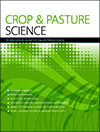Although waterlogging is known to decrease grain yield in wheat (Triticum aestivum L.) and barley (Hordeum vulgare L.), a question that remains unanswered is its effect on plant N traits. Waterlogging differentially reduced N uptake and remobilisation to grains of wheat and barley depending on the developmental stage in which the stress occurred. N uptake depended mainly on the biomass accumulation, suggesting that the effect of waterlogging on N economy of wheat and barley seems to be indirect, mediated by the impact of waterlogging on growth.

Crop and Pasture Science
Volume 73 Number 6 2022
Sucrose conversion and inhibition of invertase are probably responsible for pollen abortion in wheat. TaACS2 catalyses the synthesis of ethylene precursor 1-aminocyclopropane-1-carboxylic acid, and lower levels of DNA methylation of TaACS2 may increase ethylene content, inhibiting invertase activity and affecting sucrose conversion. DNA methylation of TaACS2 gene may be involved in the sterility–fertility transition by regulating the synthesis of ethylene in S-CMS anthers.
CP21627Mapping the impact of subsoil constraints on soil available water capacity and potential crop yield
Soil constraints may impede root growth, therefore restricting the amount of water available to plants and limiting potential crop yields. This study mapped the interactions between constraints, soil water, and crop yields, concluding that 54% of the study area was affected by at least one constraint, reducing plant access to water and potential yields. Simplifying multiple sources of information into a single map offers a useful decision-making tool that can be used to support informed management decisions on farm.
CP21627 Abstract | CP21627 Full Text | CP21627PDF (6.1 MB) Open Access Article
CP21468Identification of quantitative trait loci underlying lodging of soybean across multiple environments
 and Yingpeng Han
and Yingpeng Han 
This study mapped QTLs that affect soybean lodging across multiple environments based on linkage analysis. A residual heterozygous line was used to verify the authenticity of the stable QTL qLDG-I-1, and candidate genes in the interval covered by qLDG-I-1 were predicted and their expression levels analysed. The QTLs and candidate genes identified are of significance to position cloning and could accelerate the progress of breeding soybean lodging resistance.
CP21585Soil salinity indicators and salinity build-up on saline water irrigation in seed spices
Fresh water availability is the major constraint in arid and semiarid regions, which forces farmers to use saline water for irrigation. This leads to soil salinisation and negatively impact crop production. However, alternate use of saline and fresh water depending on crop growth stage can maintain soil environment as good as fresh-water application. Seed spice crops like dill, ajwain, anise and nigella need fresh water irrigation during crop establishment and flowering stage, whereas, in between, saline water can be applied.
Twenty-two genotypes of lucerne, Greek and imported, were tested for productivity under irrigated Mediterranean conditions. Three Greek semi-winter-active genotypes and one introduced highly winter-active had the highest total yield; introduced winter-active genotypes had higher autumn and spring yields than Greek semi-winter-active, which were more persistent and productive in summer. Thus, breeding locally adapted, more winter-active, persistent genotypes with higher summer yields could increase forage yield under anticipated climate changes.
CP21570Sward structure and forage intake rate of elephant grass cv. Napier subjected to strategies of intermittent stocking management
 , Lilian Elgalise Techio Pereira, Marília Barbosa Chiavegato and Sila Carneiro da Silva
, Lilian Elgalise Techio Pereira, Marília Barbosa Chiavegato and Sila Carneiro da Silva 
Grazing management strategies in tropical grasses affect forage nutritive value and change animal grazing patterns and intake. Animals change these patterns to keep forage intake at a high level, but when the swards are managed higher than 95% of light interception (LI95%), these changes are not enough to maintain forage intake. Therefore, greater intake rate associated with greater nutritive value for the LI95% swards strongly indicates that this is the adequate grazing strategy to increase animal performance.
There is a big gap in the quality of natural Leymus chinensis in China, which needs to be filled up by artificial cultivation. This study found that combined application of macro- and micronutrient fertilisers or NP (NPK) fertiliser can substantially improve forage yield and quality as obtained by Meta-analysis. The positive effect of fertilisation on yield was also observed in the aeolian soil with pH >7.0. This study provide a basis for high-yielding high-quality L. chinensis production.
CP21652Beneficial invertebrates of dairy pastures in south-eastern Australia
 , Stuart Kemp, James L. Maino, Marielle Babineau, Isobel Roberts, Alana Govender and Paul A. Umina
, Stuart Kemp, James L. Maino, Marielle Babineau, Isobel Roberts, Alana Govender and Paul A. Umina
The Australian dairy industry depends on grass pastures to feed cattle, but these pastures also host dynamic invertebrate communities. Dairy managers traditionally focused on invertebrates that damage pastures (i.e. pests), whereas invertebrates that provide beneficial ecosystem services (e.g. biocontrol and nutrient cycling) receive less attention. Here, we provide baseline information on the beneficial invertebrate communities of Australian dairy pastures by surveying these communities across seven Australian dairy regions and explored how environmental and farm management factors shape these communities.



